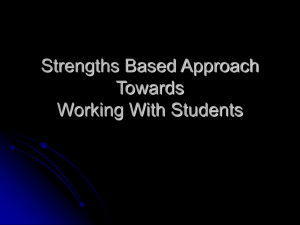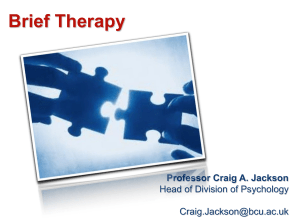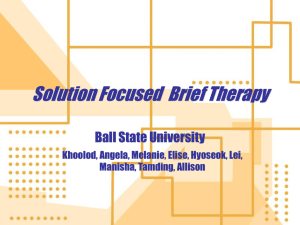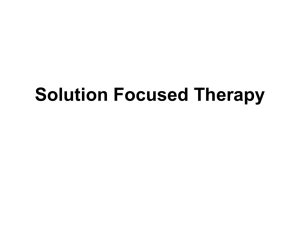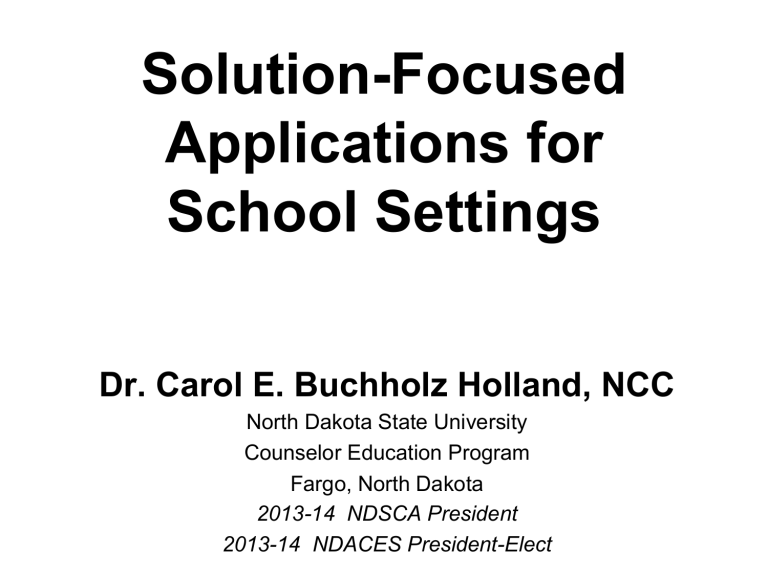
Solution-Focused Applications for School Settings Dr. Carol E. Buchholz Holland, NCC North Dakota State University Counselor Education Program Fargo, North Dakota 2013-14 NDSCA President 2013-14 NDACES President-Elect Objectives • Gain an understanding of the solution-focused approach. • Learn how to use solution-focused questions & skills for counseling sessions, classroom management, small-group settings, parent meetings, teacher consultation, and more. • Gather solution-focused assessment tools for collecting data from students, teachers, and parents. Solution-Focused Approach • One of the principles reflected in the Solution-Focused approach is more time spent focusing on solutions, less time focusing on problem talk. • Since we tend to get what we notice, we need to notice what we want to get! (Cottrell, 2000) Solution-Focused Approach Has become popular because: • It is flexible • It focuses on a person’s strengths, which reportedly energize staff • It is claimed to yield rapid and enduring change, and a high degree of client satisfaction (Stalker, Levene, & Coady, 1999; Williams, 2000) Key Assumptions of Solution-Focused Counseling 1. If it isn’t broke, don’t fix it. If it works, do more of it. If it doesn’t work, do something . 2. Every client is unique, resourceful, and capable of changing. 3. Clients are experts on their own lives. The client’s own goal drives the activities. 4. Everybody is invested in solutions they generate. 5. No problem is constant. 6. Big problems do not always require big solutions. (Murphy, 2008) Solution-Focused Practice • A key part of effective work with children is to make their strengths and abilities more evident to them and the adults in their lives. • Identification of these resources forms the basis of each child’s unique solutions to their problems and develops resilience. (Berg & Steiner, 2003) Concept 1: Focus on the Present & Future When counselors help clients identify what will have to happen in their world to tell them they no longer need counseling, it conveys the assumption that things will be better in the future. Trying to understand the past can be overwhelming to many clients & some may use it as a scapegoat to inhibit personal growth. (Sklare, 2005, p. 14) Concept 2: Focus on Actions Rather Than Insights • Children’s levels of cognitive development limit their ability to comprehend insights about their problems. • Insight development also requires a time commitment that students & school counselors don’t have. • Metcalf (1995) states “knowing why we are the way we are doesn’t offer solutions. As students discover why they are sad, they often use this information as a symptom or reason for not succeeding” (p. 19). (Sklare, 2005, p. 16) Scaling Questions • Used to assess goals, progress, or even motivation to change or take action. • They encourage a sense of moving forward (even if the score is 0). • They ask the client to describe what it would be like at different score. • The clients are asked what would need to happen to move up a scaling point and what needs to happen to stay at a certain scaling point. (Cottrell, 2000) Scaling Questions cont. Use a scale from 1 to 10 & design the scale with client (“1” being____, “10” being ___) 1. “What tells you that you are at a ‘6’?” 2. “How is ‘6’ different for you than a ‘3’?” 3. “What would others (family, friend, etc.) say where you are at on the same scale?” Scaling Questions cont. 4. “What would it take to move it up 1 point higher on the same scale?” 5. “When you move 1 point higher, what would you be doing differently in your life?” “With your family (friends, etc.)?” 6. Sometimes you may want to ask: “How come you are not a ‘-3’?” “What are you doing well?” “What do you have to do so that you can stay at a ‘1’?” (Berg & Steiner, 2003) The Miracle Question The Miracle Question helps to: • • • • • • • Set goals Start talking about situations after solution Avoid differing problem definitions Develop solutions separate from the problem Explore new possibilities Reduce blame about the problems Broaden the context, and in fact may solve more than one problem (Cottrell, 2000) The Miracle Question “Imagine tonight while you are sleeping a miracle occurs. The miracle is the difficulties and problems that have brought you here (to counseling) have somehow been resolved while you were sleeping.” “What is the first small thing that tells you this miracle has happened (and what else, etc., etc.)” “What would you be doing or what would you notice that is different to tell you the miracle has occurred?” “What would other people notice you were doing?” *** Make sure to focus on details. (Cottrell, 2000) Exceptions Exceptions are circumstances when the problem did not occur, or occurred with less frequency (or less severe). They are used to help the client discover solutions. (Murphy, 1997) Recognizing & Utilizing Exceptions Assumes that the intensity of problems fluctuates constantly. • Elicit times when the problem was absent, less intense, or less frequent. • Elaborate on features and circumstances of these times. • Expand exceptions to other contexts. (Murphy, 1997) Exception-Seeking Questions • “Are there times when the problem doesn’t happen or is less intense or less frequent?” • “When was this?” • “What was different?” • “How did you make that happen?” Examples of Exception-Seeking Questions for a Student “I see that you passed 4 out of your 7 classes.” “How did you manage to pass those 4 classes?” (or “What did you do?”) “What would your teachers say you did that worked for you?” “What did the teachers do that worked for you?” (Metcalf, 1995, p. 48) Examples of Exception-Seeking Questions for a Teacher “When was the last time you did notice Cory sitting still in his seat?” “What was going on in class at the time?” “Where was he sitting?” “Who was there?” (Metcalf, 1995, p. 48) Rapid Change is Possible Rapid change is possible when we use the solution-focused approach to help identify exceptions. (Metcalf, 1995, p. 26) The Coping Question The question works well when students are going through really hard times & can barely find energy to do something about their problems. “What helps keep you going even though things are really hard?” Task Development & Goal Setting Use task development question after exception-seeking and scaling questions have been used to help client identify his/her successes. The goal setting process provides a sense of action and forward movement toward problem resolution. Task Development Question (Goal Setting) “Based on the success you have described today regarding this problem, what is one small goal you can set to encourage this new behavior?” Connect Task/Goal with Previous Success When using the solution-focused approach, never ask a person to do something he/she has not done before successfully. Always connect a task with a similar successful action the person has taken previously. (Metcalf, 1995) RememberGo Slowly and Focus on Tasks “Cautioning students to go slowly prevents slow success from being perceived as failing or not happening fast enough.” (Metcalf, 1995, p. 25) “Change takes time. The best changes occur over time. Take small steps.” (Metcalf, 1995, p. 86) Useful Language Skills • “Yes… And” (Not “Yes...But”) • “Suppose…Just suppose….” • “Tell me more about…” (Berg & Steiner, 2003) “Not Knowing” Skills • Use client’s exact words, then weave it into your next question. • Accept what the client wants as valid and reasonable: “You must have a very good reason for (e.g., skipping school). Tell me more about it.” • “How is this problem for you?” • “When things are different, what would you do then that you are not doing now?” (Berg & Steiner, 2003) Comparing Problem-Solving Schools to Solution-Focused Schools Problem-Solving Solution-Focused • “Why did you do that?” • Emphasis on past • Problem-talk • Attention on what is wrong • Student is flawed • “How did you do that?” • Focus on the future • Solution-talk • Attention on what is working • Student is capable Comparing Problem-Solving Schools to Solution-Focused Schools cont. Problem-Solving Solution-Focused • Teacher is • Teacher is skilled at “not knowing” “all-knowing” • Student is source of • Teacher is source of solution solution • Frees teacher from • Teacher accepts responsibility of responsibility for fixing “fixing” the problem the problem Shift focus from… Student taking responsibility for the problem to Student taking responsibility for the solution Applications in Schools In addition to using the solution-focused approach in Individual Counseling, it can be used in: • Classroom Management • Teacher Consultation • Parent/Teacher Conferences • Small Group Counseling Classroom Management Behavior Modification VS. “Students, thank you for your straight line.” “Cory, you stayed in your seat nicely this morning. Good for you.” Solution-Focused Approach “Students, this line is so straight. How did you managed to be so cooperative with each other?” “Cory, I am amazed at you today! I noticed how you sat in your chair and stayed focused. How did you do this today? WOWW (Working on What Works) “An innovative program designed to enhance the quality of education in the classroom” (Berg & Shilts, 2004, p. 8). • https://www.youtube.com/watch? v=zdOUyWTpUTc • http://www.tandfonline.com/doi/pdf/ 10.1080/02667363.2012.684341 Berg, I.K., & Shilts, L. (2004). Classroom solutions: WOWW approach. Milwaukee, WI: Brief Family Therapy Center Press. Berg, I.K., & Shilts, L. (2005). Classroom solutions: WOWW coaching. Milwaukee, WI: Brief Family Therapy Center Press. Examples of Teacher Consultation Questions • “What do you do or say differently when you and the student are getting along better?” • “Do the good times occur more in the mornings or afternoons? • “Where is the student sitting when things are a little bit better (e.g., in front of classroom, in back of room, by your desk)?” Solution-Focused Parent/ Teacher Conferences • “When working with students, teachers, parents, and administrators, searching for more efficient, successful, happier times solicits solutions.” (Metcalf, 1995, p. 9) • Look for exceptions. SOLUTION-FOCUSED GROUP COUNSELING SESSION 1. Set the mood for focusing on solutions • “What brings you to our group today? 2. Goal setting • “How will you know when things are better for you?” 3. Searching for exceptions to the problem • “Let’s talk about times when things are not as tough.” (LaFountain & Garner, 1996) SOLUTION-FOCUSED GROUP COUNSELING SESSION cont. 4. Encouraging motivation • “Someday when the problem that brought you here today doesn’t bother you as much, what will you get to do more?” 5. Task Development • “Let’s talk now about what you might do next week that will assist you in keeping the problem at a distance in your life.” 6. Wrap up * “What did we do in group today that made a difference?” (LaFountain & Garner, 1996) ASSESSMENT Young Child Outcome Rating Scale (YCORS) & Young Child Session Rating Scale (YCSRS) http://www.mnfamilycenter.com/userfiles/ 1167979/file/Child%20Measures %20MFC.pdf Child Session Rating Scale (CSRS) & Child Outcome Rating Scale (CORS) http://mnfamilycenter.com/userfiles/ 1167979/file/Youth%20Measures %20MFC(1).pdf ADDITIONAL RESOURCE Solution Focused Brief Counseling: From Problem Solver to Solution Seeker Russell A. Sabella, PhD Florida Gulf Coast University This packet available online at: http://bit.ly/sfbc-handout School Counseling Solutions Web Sites with Assessment Tools Created by Around Schonberg, M.S. & Keith Fulthorp, Ed.D. https://sites.google.com/site/ schoolcounselingsolutions/ https://sites.google.com/site/ schoolcounselingsolutions/individualsolution-strategies CONTACT INFORMATION: Dr. Carol E. Buchholz Holland North Dakota State University Counselor Education Program 1919 N. University Dr., Suite C Fargo, North Dakota 58102 (701) 231-7103 (OFFICE) Carol.E.Buchholz@ndsu.edu References Berg, I. K., & Steiner, T. (2003). Children’s solution work. New York: W.W. Norton. Cottrell, S. (2000). Solution focused therapy workshop notes. Retrieved October 9, 2005, from http://www.clinicalsupervision.com/Solution%20Focused%20Therapy&20Workshop%20 LaFountain, R. M., & Garner, N. E. (1996). Solution-focused counseling groups: A key for school counselors. School Counselor, 43(4), 256-267. Metcalf, L. (1995). Counseling toward solutions: A practical solution-focused program for working with students, teachers, and parents. San Francisco, CA: Jossey-Bass. Murphy, J. J. (1997). Solution-focused counseling in middle and high schools. Alexandria, VA.: American Counseling Association. Sklare, G. B. (2005). Brief counseling that works: A solution-focused approach for school counselors and administrators (2nd ed.). Thousand Oaks, CA: Corwin Press.
